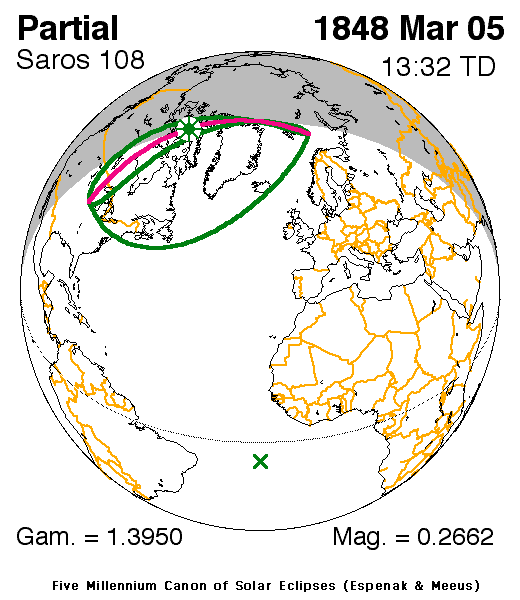|
Solar Eclipse Of November 30, 1853
A total solar eclipse occurred at the Moon's Lunar node, descending node of orbit on Wednesday, November 30, 1853, with a Magnitude of eclipse, magnitude of 1.0485. A solar eclipse occurs when the Moon passes between Earth and the Sun, thereby totally or partly obscuring the image of the Sun for a viewer on Earth. A total solar eclipse occurs when the Moon's apparent diameter is larger than the Sun's, blocking all direct sunlight, turning day into darkness. Totality occurs in a narrow path across Earth's surface, with the partial solar eclipse visible over a surrounding region thousands of kilometres wide. Occurring about 8.5 hours before Apsis, perigee (on December 1, 1853, at 3:45 UTC), the Moon's apparent diameter was larger. The path of totality was visible from parts of modern-day Peru, Bolivia, and Brazil. A partial solar eclipse was also visible for parts of northern Oceania, Hawaii, southern North America, Central America, the Caribbean, and South America. Observations ... [...More Info...] [...Related Items...] OR: [Wikipedia] [Google] [Baidu] |
Solar Eclipse
A solar eclipse occurs when the Moon passes between Earth and the Sun, thereby obscuring the view of the Sun from a small part of Earth, totally or partially. Such an alignment occurs approximately every six months, during the eclipse season in its new moon phase, when the Moon's orbital plane is closest to Ecliptic, the plane of Earth's orbit. In a total eclipse, the disk of the Sun is fully obscured by the Moon. In #Types, partial and annular eclipses, only part of the Sun is obscured. Unlike a lunar eclipse, which may be viewed from anywhere on the night side of Earth, a solar eclipse can only be viewed from a relatively small area of the world. As such, although total solar eclipses occur somewhere on Earth every 18 months on average, they recur at any given place only once every 360 to 410 years. If the Moon were in a perfectly circular orbit and in the same orbital plane as Earth, there would be total solar eclipses once a month, at every new moon. Instead, because the Mo ... [...More Info...] [...Related Items...] OR: [Wikipedia] [Google] [Baidu] |
Eclipse Season
An eclipse season is a period, roughly every six months, when eclipses occur. Eclipse seasons are the result of the axial parallelism of the Orbit of the Moon, Moon's orbital plane (orbital inclination, tilted five degrees to the ecliptic, Earth's orbital plane), just as Earth's Season, weather seasons are the result of the axial parallelism of Earth's axial tilt, tilted axis as it orbits around the Sun. During the season, the "lunar nodes" – the line where the Moon's orbital plane intersects with the ecliptic, Earth's orbital plane – align with the Sun and Earth, such that a solar eclipse is formed during the new moon phase and a lunar eclipse is formed during the full moon phase. Only two (or occasionally three) eclipse seasons occur during each year, and each season lasts about 35 days and repeats just short of six months (173 days) later, thus two full eclipse seasons always occur each year. Either two or three eclipses happen each eclipse season. During the eclipse seaso ... [...More Info...] [...Related Items...] OR: [Wikipedia] [Google] [Baidu] |
November 1844 Lunar Eclipse
November is the eleventh and penultimate month of the year in the Julian and Gregorian calendars. Its length is 30 days. November was the ninth month of the calendar of Romulus . November retained its name (from the Latin ''novem'' meaning "nine") when January and February were added to the Roman calendar. November is a month of late spring in the Southern Hemisphere and late autumn in the Northern Hemisphere. Therefore, November in the Southern Hemisphere is the seasonal equivalent of May in the Northern Hemisphere and vice versa. In Ancient Rome, Ludi Plebeii was held from November 4–17, Epulum Jovis was held on November 13 and Brumalia celebrations began on November 24. These dates do not correspond to the modern Gregorian calendar. November was referred to as Blōtmōnaþ by the Anglo-Saxons. Brumaire and Frimaire were the months on which November fell in the French Republican calendar. Astronomy November meteor showers include the Andromedids, which occurs from Se ... [...More Info...] [...Related Items...] OR: [Wikipedia] [Google] [Baidu] |
Solar Eclipse Of January 11, 1861
Solar may refer to: Astronomy * Of or relating to the Sun ** Solar telescope, a special purpose telescope used to observe the Sun ** A device that utilizes solar energy (e.g. "solar panels") ** Solar calendar, a calendar whose dates indicate the position of the Earth on its revolution around the Sun ** Solar eclipse, an eclipse of a sun in which it is obstructed by the moon ** Solar System, the planetary system made up by the Sun and the objects orbiting it * Solar Maximum Mission, a satellite * SOLAR (ISS), an observatory on International Space Station Music * "Solar" (composition), attributed to Miles Davis * ''Solar'' (Red Garland album), 1962 * ''Solar'' (Taeyang album), 2010 * ''Solar'', a 2011 album by Rubik * "Solar", a song by Northlane from ''Mesmer'', 2017 * "Solar", a song by Sault from ''Air'', 2022 * ”Solar”, a song by Stam1na from ''Taival'', 2018 * SOLAR Records, a record label Geography * Solar (Spanish term), a type of urban site * Solar, County ... [...More Info...] [...Related Items...] OR: [Wikipedia] [Google] [Baidu] |
Solar Eclipse Of January 21, 1852
A partial solar eclipse occurred at the Moon's Lunar node, descending node of orbit on Wednesday, January 21, 1852, with a Magnitude of eclipse, magnitude of 0.4577. A solar eclipse occurs when the Moon passes between Earth and the Sun, thereby totally or partly obscuring the image of the Sun for a viewer on Earth. A partial solar eclipse occurs in the polar regions of the Earth when the center of the Moon's shadow misses the Earth. It was first of three partial eclipses that took place that year within the space of nearly six months, the last one was in June 1852 in the same hemisphere with a very tiny portion in the same area with the previous eclipse but the remainder in South America. Description The eclipse was visible in almost the whole of Antarctica which had a 24-hour daylight with the exception of one part of the mid northernmost area of Antarctica by the Indian Ocean and around the area of the Antarctic Circle, a small piece of southernmost Tasmania with Hobart, Tasmani ... [...More Info...] [...Related Items...] OR: [Wikipedia] [Google] [Baidu] |
June 1853 Lunar Eclipse
June is the sixth and current month of the year in the Julian calendar, Julian and Gregorian calendars—the latter the most widely used calendar in the world. Its length is 30 days. June succeeds May and precedes July. This month marks the start of summer in the Northern Hemisphere and contains the summer solstice, which is the day with the most daylight hours. In the Southern Hemisphere, June is the start of winter and contains the winter solstice, the day with the fewest hours of daylight out of the year. In places north of the Arctic Circle, the June solstice is when the midnight sun occurs, during which the Sun remains visible even at midnight. The Atlantic hurricane season—when tropical cyclone, tropical or subtropical cyclones are most likely to form in the north Atlantic Ocean—begins on 1 June and lasts until 30 November. Several monsoons and subsequent wet seasons also commence in the Northern Hemisphere during this month. Multiple meteor showers occur annually ... [...More Info...] [...Related Items...] OR: [Wikipedia] [Google] [Baidu] |





